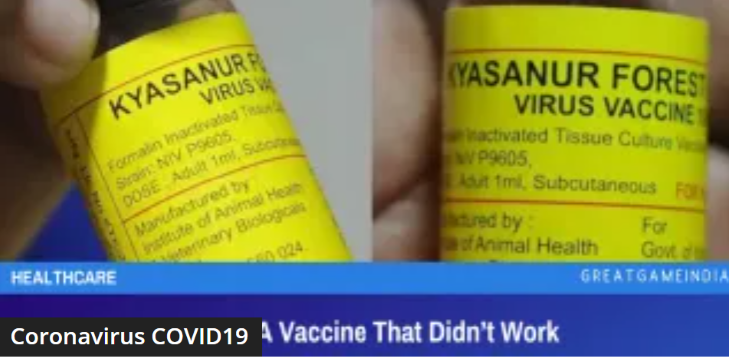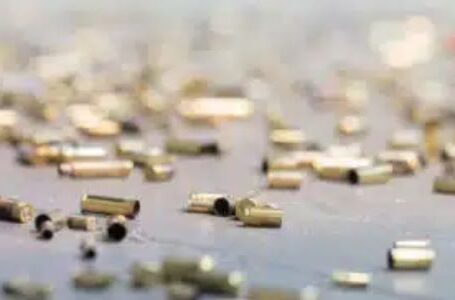The Ugly Truth About A Vaccine That Didn’t Work

The KFD pathogen can be fatal. The jab meant to counteract it, however, lost its effectiveness as the regulator dozed off. This is the ugly truth about a vaccine that didn’t work.
- EXPLOSIVE: Here’s what was uncovered in Hunter Biden’s iCloud Hack
- MAJOR PEER REVIEWED STUDY: Moderna Vaccine Increases Myocarditis Risk By 44 Times In Young Adults
- MUST READ:High Level International Bankers Simulate The Collapse Of Global Financial System
- BIG STORY:Wuhan Lab Isolated Monkeypox Strain In 2020
- EXPLOSIVE:Ukraine Biolabs Used Fever Carrying Mosquitoes To Spark Dengue Pandemic In Cuba

Karnataka’s department of health and family welfare sent an unusual circular to all district health officials on October 10, 2022. The circular, written in Kannada, discussed the scarcity of a vaccination against Kyasanur Forest Disease (KFD), a devastating disease that mostly affects forest and agricultural workers. According to the circular, no vaccination would be available for the forthcoming KFD illness season, which runs from November to May. As a result, the health department directed officials to combat this tick-borne disease by alternative means, such as teaching individuals on how to avoid tick bites.
The circular was strange in a number of ways. The best line of defense against the disease is generally agreed to be the KFD vaccination. Considering that there is no specific treatment for KFD and that forest workers are more at risk, it might be challenging to avoid tick bites. Additionally, the state had been using the vaccination for almost 33 years. So why did the health department decide to cease administering the vaccine all of a sudden?
The circular concealed the reality that this decision was not one that was made suddenly. On the contrary, the vaccine had endured more than 20 years of regulatory and quality issues. Among these issues was the fact that the vaccine’s manufacturer, the Institute of Animal Health and Veterinary Biologicals (IAHVB), centered in Bengaluru, had not received authorization from India’s top drug regulator, the Central Drugs Standard Control Organization (CDSCO), to produce the KFD vaccine since at least 2002. In other words, it could be argued that the distribution of this vaccination in India had been prohibited for 21 years.
The vaccine’s quality had significantly declined during the past two decades without the CDSCO in the picture. In particular, the vaccine had been consistently failing “potency” tests. How well a vaccine can prevent KFD in people is determined by the potency of the vaccine, which is tested in animals. In other words, the potency and ‘effectiveness’ of the vaccine are tightly related. Therefore, if a vaccine fails a potency test, it may no longer be able to provide adequate protection against KFD.
Regrettably, the media discovered at least two cases in which the KFD vaccination’s producer, IAHVB, and quality-testing lab, the Shivamogga-based Government Virus Diagnostic Laboratory (VDL), had made the vaccine available to the general public despite the vaccine failing potency tests. The Karnataka health department has also given its approval to these alarming choices.
Furthermore, investigation revealed that the IAHVB, VDL, and health department had not operated independently. One of the leading public health organizations in the nation, the National Institute of Virology (NIV), supported their decisions. Journalists also discovered that NIV frequently recommended cosmetic remedies to the issue of declining potency rather than requesting IAHVB to halt production entirely. As a result, the NIV, which is a part of the Indian Council of Medical Research, the country’s top government-sponsored medical research organization, assisted the vaccine’s maker in disseminating an ineffective vaccine.
The cost of this multi-level institutional incompetence was ultimately borne by the public. In the past, IAHVB has sold the KFD vaccine to at least five Indian states: Karnataka, Goa, Maharashtra, Tamil Nadu, and Kerala. However, these states were spending money on an ineffective shot whose quality and safety were in dispute.
The National Institute of Epidemiology in Chennai has undertaken studies that demonstrate that by the middle of the 2000s, the vaccine’s efficacy had significantly decreased. The National Institute of Epidemiology, a sister organization of NIV under the Indian Council of Medical Research, used KFD data (read below) from 2005 to 2010 to determine that one vaccine dose’s effectiveness during this time period was zero, as opposed to 79.3% in a 1994 research. However, compared to 93.5% in 1994, only 62% of two doses were effective.
As a result, the majority of beneficiaries of a single dose were not shielded from the potentially fatal KFD. In the Western Ghats regions of the affected states, the disease, which sickens about 500 individuals a year, is often mild and characterized by fever and chills. However, the virus might develop into a fatal form in 5–10% of patients. The virus can affect many organs or cause haemorrhagic symptoms, such as bleeding from the eyes, nose, or intestines, in cases of severe illness. A case fatality rate of between 5 and 10% is not negligible; by contrast, one estimate places the death rate from dengue at 2.6% of confirmed cases.
Healthcare professionals in areas affected by the KFD were aware of the apparent decline in vaccine efficacy, and many of them lost faith in the shot. In a July 2022 interview with Mint, Krishna, a community health officer in the Kannangi hamlet of Karnataka’s Shivamogga district, said, “I don’t think it works.”
The entire incident also calls into doubt CDSCO’s effectiveness as India’s national regulator, which was already questioned following the deaths of 69 children in The Gambia as a result of ingesting tainted Indian cough medication.
The media discovered that the national authority did little to address the problem despite being frequently informed—since at least 2020—that the KFD vaccination was being used in Karnataka without its authorization.
The beginnings
Despite NIV’s disturbing role in the development of the KFD vaccine, the institute is praised for its historical achievements to research the illness and create the vaccine. Scientists from NIV were the first to identify the virus from the Kyasanur Forest, a tropical highland forest dotted with rice plantations, in 1957.
They were looking into a puzzling local haemorrhagic fever outbreak that appeared to be connected to the local monkey population’s demise. Due to this, it was unclear if the outbreak was Yellow Fever. It was a haemorrhagic fever that had previously only been found in South America and Africa, and it attacked both people and monkeys.
But when the virus was isolated from a Hanuman langur, researchers from NIV discovered that it was a different pathogen from the Yellow Fever virus. The Kyasanur Forest, where the virus was first discovered, inspired its name.
A preliminary working theory on where in the forest the virus was originating from was also developed by NIV researchers; their findings revealed that the virus persisted in rodents. However, they discovered that monkeys were crucial in the spread of disease. Monkeys amplified the virus after being exposed to it by ticks, making their bodies disease hotspots. Unwary forest inhabitants who ventured close these sick monkeys were quite likely to contract the disease, once more through tick bites. Because of this, KFD is also known as the Monkey Fever or manganakayile in Kannada.
The formalin-inactivated vaccine was created by a group of NIV virologists under the direction of CN Dandawate in the 1960s, which marked another significant development. The vaccination generated protective antibodies against KFD and also prevented sickness, according to early trials conducted on NIV employees and Shivamogga inhabitants.
Dandawate’s work could not have come out at a better time considering KFD’s geographic reach, which was first limited to Shivamogga, was steadily growing. The virus soon spread to Maharashtra, Goa, Kerala, and Tamil Nadu after first showing in new Karnataka areas for about 40 years.
The disease commonly affects agricultural or forestry workers in all of these areas. A severe instance may result in death or a person’s inability to work for months, which would result in a considerable loss of revenue.
One such patient is Raghavendra C S, a 42-year-old headmaster of a school in the Karnataka region of Davangere. Raghavendra experienced a fever in January 2020 that just would not go away. He lives in Davangere, where there has never been a KFD outbreak, thus no doctor ever believed he had this tick-borne illness. But as the fever persisted for nearly ten days, his family drove him an hour away to a hospital in the Shivamogga district. He entered a coma shortly after arriving at the hospital because the illness had spread to his brain.
At this point, a physician at the Shivamogga hospital developed suspicions regarding KFD and sent samples for analysis. The outcome was positive. Raghavendra now thinks he might have contracted the illness when traveling from Davangere to another town in Shivamogga, where KFD outbreaks do happen, for only a single day.
Raghavendra claims that he was hospitalized for a total of 12 days, some of which were spent using a mechanical ventilator. His family paid the expenses with more than 3 lakh. According to Raghavendra, when he came out of the coma, he had lost a lot of weight and shown neurological signs. “It was hell. It is difficult to say how it felt. Everything was difficult, including walking.” Nearly three years later, he claims to have almost entirely healed but still experiences symptoms like amnesia.
Control of KFD is a crucial political tenet due to the serious threat this illness poses to the inhabitants of Karnataka’s forested Western Ghats region. A successful vaccine is highly desired because forest residents can only do so much to prevent tick attacks. A public-interest lawsuit was brought in 2019 by two Shivamogga-based attorneys, who contended that the state had not done enough to rein in KFD. The first of the six prayers presented by the advocates was for increased accessibility to the KFD vaccine.
Ironically, it may have been due to public pressure like this that the Karnataka health authorities continued to use the vaccine even after its efficacy was questioned.
Vaccine production begins
In 1989, the Karnataka government established a manufacturing facility under VDL Shivamogga after realizing the necessity for a vaccine. The NIV moved the technology from CN Dandawate to this site and provided manufacturing support for approximately ten years. A second field research was carried out by Dandawate’s team at this time to gauge the vaccine’s efficacy. At that time, they discovered that the vaccination was reassuringly successful after just one dose—79.3%—and after two—93.5%.
However, VDL did not produce the vaccine for very long. Since VDL lacked sufficient infrastructure, the Karnataka government chose to relocate manufacturing to IAHVB in 2000. However, IAHVB was never the best location to manufacture the vaccine. The institute had previously solely produced the less strictly controlled animal vaccinations. Why then did the government pick this location?
The administration solicited more seasoned private-sector vaccine makers, but they expressed no interest in producing the KFD shot, which is part of the explanation. Only 1–5 lakh vaccine doses are produced each year to protect the people at risk due to the disease’s limited geographic distribution. According to various government officials, this low quantity is unattractive to producers in the private sector. “If anyone came forward to make it, we would have given it to them. But nobody is coming forward,” according to KJ Harshavardhan, VDL’s deputy chief medical officer, in an interview from June.
With a joint license from the CDSCO and the Karnataka drugs control department, IAHVB started production in 2000 in light of these limitations. Documents indicated that this license was set to expire in December 2001.
When the CDSCO grants a manufacturer permission to produce a vaccine, it also approves the process used to develop the vaccine as well as every batch of quality checks that manufacturer is required to do. After that, it is against Indian drug laws if the maker distributes a vaccination that fails a quality-control test.
The following describes the KFD vaccine manufacturing process: IAHVB initially extracts a sample of the master seed, a 1957 strain of the KFD virus, from the NIV. Then, mice are used to multiply this master seed once. The outcome is a significant volume of virus, or working seed.
In chicken embryonic cells, the working seed is then multiplied once more. After that, IAHVB inactivates the virus using the substance formalin. The vaccine is produced as a result, which IAHVB cleanses and bottles.
The final quality-control tests are carried out as the next step. The potency test was one of the numerous quality checks that the CDSCO mandated the vaccination go through. The potency test procedure and the minimal standard that each batch required to meet were both approved by CDSCO.
The CDSCO-approved potency-test procedure went something like this: initially, a technician would immunize one group of mice twice, three days apart, with the KFD vaccine. The mice that had received the vaccine as well as a separate, uninfected group, known as the controls, would then be inoculated with live KFD virus seven days later.
The technician would determine a potency value, let us say X, by comparing the proportion of mice in each group that perished. X had to be higher than a minimum value, let us say Y, in order for the vaccine to be made available to the general population.
The CDSCO disappears
As soon as IAHVB’s initial manufacturing license for the KFD vaccination expired in December 2001, things began to go awry. The institute then requested a license renewal from the Karnataka narcotics control department for a five-year period, from 2002 to 2006.
It is important to remember that the state where the company is located’s medicines control department is responsible for issuing licenses under India’s joint licensing system for vaccines. However, it is unable to do so prior to receiving permission from the CDSCO.
But according to B M Chandra Naik, a scientist in charge of IAHVB’s KFD vaccine production, the Karnataka medicines control department did not respond to IAHVB’s application. IAHVB still persisted in producing the vaccine, relying on a gap in the Drugs and Cosmetics Act. A manufacturer’s license is still valid, according to this loophole, if they requested for a renewal before the end of the last license period and their application was not specifically turned down.
When the IAHVB’s second, third, and fourth license periods—specifically, the 2002–2006, 2007–2011, and 2012–2016 periods—expired, the situation recurred. In other words, the Karnataka drugs control department did not reply to any of the IAHVB’s requests for renewal. IAHVB nevertheless kept producing the vaccine.
Chandra Naik claims that it was not until 2020 that the corporation received a response from the narcotics control division. The department then sent the firm three licenses in a single exchange: two retroactive licenses (for the 2007–2011 and 2012–2016 years) and one prospective license (for 2017-2021 period).
But these long-delayed licenses just made everything more problematic. Oddly, the CDSCO had purposefully left the name of the KFD vaccination off the list of products that the IAHVB was permitted to manufacture in all three licenses. In other words, the CDSCO had retroactively revoked the company’s vaccine manufacturing license for this vaccine.
The Karnataka medicines control agency was questioned by Mint about why IAHVB was still allowed to produce the vaccine despite having its licenses revoked. In a September 2022 interview, the authorities claimed that CDSCO had taken out the name, but they admitted that they were unsure of the significance of the action. The head of the CDSCO, V G Somani, was questioned multiple times since 2020, according to Bhagoji Khanapure, the medicines controller for Karnataka. But he said that Somani never responded. “He himself doesn’t know what it means.”
The CDSCO never provided an explanation for why the licenses were revoked, thus the drugs control department presumed the licenses were still in effect in the absence of a response from Somani.
However, Khanapure’s assessment is questionable. Mint discovered that the CDSCO had not fulfilled any of its obligations as a licensing body for the time frame in which it had removed the name of the KFD vaccination, beginning in 2006.
For instance, a CDSCO facility called the Central Drugs Laboratory in Kasauli, Himachal Pradesh, assesses the quality of each batch before the public receives any licensed human vaccines sold in India. However, the Kasauli lab claimed that it had never tested the KFD vaccination in response to a request Mint made under the Right to Information Act.
Additionally, according to a different document found on the CDSCO website, the CDSCO stopped considering IAHVB to be a manufacturer of human vaccines at least from 2009. IAHVB is not mentioned in the publication, which is a list of all CDSCO-approved producers of human vaccines since 2009.
A low potency batch
The CDSCO failed to fulfill any of its obligations, which caused a decline in the KFD vaccine’s quality. The Karnataka health department frequently sought guidance from the NIV to address the quality issues despite the NIV’s lack of experience with large-scale vaccine production. And the guidance offered by the NIV was dubious.
The minutes of a meeting held by the Karnataka health department in 2012 give a preliminary indication of these issues. Senior IAHVB personnel as well as Raghuram Bhandary, who was the additional drugs controller at the time, a representative from the Karnataka drug control agency, attended the meeting on October 4. There were also representatives from the Shivamogga Government Virus Diagnostic Laboratory (VDL), which was assisting IAHVB with some of the last quality checks on the vaccine at the time.
A joint director from the health department opened the meeting. After greeting everyone, he informed them that the potency of a recent batch of the KFD vaccination was “slightly low.”. However, “in view of the urgency,” he stated, —a reference to the fact that the KFD breakout season was only a month away—the attendants should allow the batch to be released.
The minutes reflect that the attendees agreed. Press contacted five of the attendees, including Bhandary, to inquire how they had approved the release of a low potency batch, despite the fact that it would have been illegal. All of them refused to comment.
The co-director then put forward another request to the audience. He said that Devendra T. Mourya, a senior NIV virologist, had proposed a “minor change” to the way the IAHVB gauges vaccine potency in mice. Mourya had conducted in-depth study on viral infections and was then among the top scientists at NIV. He would become the director of NIV the very following year. The joint director requested the creation of a new expert-led subcommittee to approve Mourya’s suggested adjustment.
Two months later, in December 2012, the director of the IAHVB and the subcommittee met. The meeting’s minutes reveal a number of things. The committee observes that because the vaccine-virus had undergone several “passages” over time, it is possible that this is why the vaccination was failing potency testing.
Simply put, this indicates that despite the fact that the NIV master seed should only have been duplicated twice before the vaccine was created—once in mouse and once in chicken embryo cells—it had really been multiplied numerous times, which is against proper manufacturing methods. Such severe passaging may change the genetic makeup of the virus, decreasing the effectiveness of the vaccination.
The only way for IAHVB to fix the issue if this is what the subcommittee thought would have been to obtain new master seed from NIV and create the vaccine from scratch. The minutes show that Mourya was instead proposing a modification to the potency-test procedure to address this issue.
In addition to being a cosmetic solution to the potency issue, IAHVB was not authorized to make such alterations to a licensed vaccine without first consulting the CDSCO. However, as Mint’s investigation reveals, CDSCO had long since stopped renewing the company’s license.
It was not the last time that NIV provided IAHVB with dubious answers. Once more, in 2022, it took place.
Vaccine effectiveness drops
IAHVB was struggling to deal with the vaccine’s diminishing effectiveness as its potency fell. In the 2000s, early indications of this were published in the scientific literature. Data from five Karnataka districts were used in a 2006 assessment by a virologist from the Defence Research and Development Establishment, Gwalior, to demonstrate that the frequency of KFD cases increased between 1999 and 2004 despite routine vaccination.
Seven years later, additional tangible proof that the vaccine was ineffective surfaced. A significant KFD outbreak occurred in the Shivamogga district in 2011–12, and many of the affected people had already received two doses of the vaccination. This was strange considering Dandawate’s 1994 study estimated that two dosages had a 93.5% efficacy rate.
According to Manoj Murhekar, director of the National Institute of Epidemiology in Chennai, a sister organization of the NIV under the Indian Council of Medical Research, the frequent outbreaks had also led to residents’ suspicion that the vaccination was not working. “If you talked to any medical officer of the district (at that time), they would all say that the vaccine, really, is of no value; it offers very little protection,” Murhekar stated.
Along with representatives from the health department, Murhekar’s team performed an efficacy study in Shivamogga to go deeper. One dosage of the vaccine, according to this 2013 study, provided the people of Shivamogga with essentially no protection during the outbreak in 2011–2012.
The researchers did a second investigation after being fascinated by the results, this time using outdated data from 2005 to 2010. Once more, they discovered that those who just received one dose were not at all protected. Furthermore, compared to the 93.5% protection predicted by Dandawate’s study, two dosages only offered 62.4% protection.
Murhekar et al again analyzed the statistics in 2013–14 when a second outbreak hit Shivamogga. The conclusion remained the same: the second dose was not as effective as previously thought while the first dose was worthless against the sickness.
State governments suffered a twofold blow as a result of this decline in effectiveness. Since the KFD vaccine requires booster shots to be administered to recipients after the first two doses, it is already a logistically challenging vaccine for state governments to provide.
Pradeep Awate, state surveillance officer for Maharashtra under the Integrated Disease Surveillance Programme of India, adds that many patients find the KFD shot to be uncomfortable, which deters them from getting repeat treatments. Against this backdrop, the Maharashtra government’s own unpublished statistics showed limited efficiency of the vaccine, and all of this combined led to the Maharashtra government suspending vaccine use in 2019. “People taking the first dose sometimes don’t want to take the second,” he said.
However, because the results of the potency tests were confidential, few people saw the connection between the decline in effectiveness and them. The declining effectiveness perplexed Murhekar because it ran counter to Dandawate’s conclusions. According to Murhekar, all he was aware of at the time was the fact that “something drastic had happened” in between Dandawate’s 1994 publication and his studies.
NIV stops usage
As concerns regarding the vaccination grew, the NIV separately came to the conclusion that its use was not warranted. NIV had been studying the KFD virus for years in its own high-biocontainment facilities. It had been immunizing its employees with IAHVB’s vaccine to guard against unintentional infections.
Prior to 2018, the NIV created assays to identify two categories of antibodies produced in response to infection or immunization. The organization then checked for these antibodies in its immunized workforce. “We didn’t see a very good antibody response. The vaccine wasn’t working,” Pragya Yadav, a senior virologist at NIV, stated that the vaccination was not working. The Karnataka health department had been mostly consulting Yadav for recommendations since Mourya retired in 2019.
Yadav is a renowned virologist who is also credited with isolating the SARS-COV-2 virus used in Covaxin, India’s main covid vaccine. According to her, NIV stopped using vaccines entirely in 2018 due to a weak antibody response.
However, Yadav’s group never made the findings public. She continued to assist in production for VDL and IAHVB. For instance, Mint discovered proof that Yadav had been assisting VDL in carrying out a so-called “safety test,” one of the quality-control checks needed before release.
In light of this, another batch of the KFD vaccination failed a potency test in December 2021. According to documents that Mint was able to access, IAHVB was still using a virus that had lost its strength due to being passed too many times. In other words, the NIV had not yet sent them new master seed.
But Yadav directed VDL to retest the batch instead of asking them to deal with the passaging issue. By this year, the potency test was also carried out by VDL, as it had done by IAHVB in 2012. Yadav’s proposal was equally problematic as Mourya’s because VDL had not found any technical flaws in the way potency had previously been evaluated.
A loss of potency can happen for one of two reasons: either the manufacturing process was incorrect, resulting in a real loss of potency, or a technician made a mistake while conducting the test. Excessive transmission of the seed virus is an example of the first, and improper injection of the mice in the potency test would be an example of the second, which would lead to inaccurate results.
Potency testing must only be performed after a failure if a glaring fault is found, in accordance with good manufacturing methods. The batch must be recreated from scratch if the manufacturing process is flawed. Regulators around the world forbid “testing into compliance,” which is repeated testing when there is no flaw in the testing procedure and is done only to ensure that the product passes quality tests.
However, according to records that Mint was able to get, VDL heeded Yadav’s counsel, retested the vaccine, and received a favorable outcome the second time. After discarding the first “fail” score, this batch was given to many in Karnataka in January 2022.
When asked why she suggested that VDL retest when there were no issues with the testing procedure, Yadav remained silent. Mint questioned Yadav about why she had never formally requested that the health authorities stop producing the vaccination. Yadav asserted that despite numerous opportunities, the health department ignored her advise since the state lacked any other ways to regulate KFD.
“The vaccine has genuine problems. I am telling you frankly…Everybody, in every meeting, said this vaccine is not worth pursuing, but there was no option, that is why they kept continuing.”
Randeep Dev, commissioner of the Karnataka health department, was questioned about the repeated distribution of a subpar vaccination in September. Dev stated he was unable to provide a particular response since he was unaware of the relevant historical information. He added that the agency had started exploring for alternative producers and would not release another vaccine unless its efficacy was established.
After around 20 years of the CDSCO no longer extending the manufacturer’s approval, the departmental circular from his office in October 2022 finally prohibited the use of vaccines.
Even if the state of Karnataka finds a new KFD vaccine manufacturer and resolves the issues with the shot, there will still be a number of unanswered questions. How could the state, knowing the vaccine was defective, continue to deliver it to people for such a long time? How did the Karnataka drugs control department and CDSCO turn a blind eye to obvious violations of the law? Why would the NIV allow commoners to receive a vaccine that its own employees would not use? Will the vaccine ever regain the public’s trust that was lost as a result of bad government decisions?
Read the document below:






















